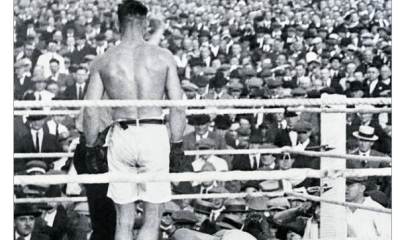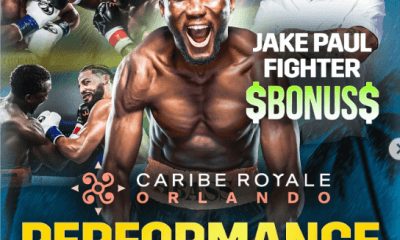Featured Articles
Canelo-Kovalev, the UFC, and the Great DAZN Flapdoodle

On Saturday, Nov. 2, Canelo Alvarez became a world title-holder in a fourth weight class with an 11th-round knockout of Sergey Kovalev. But the big winner that night was Dana White. The brassy, 50-year-old President and poster boy for the UFC, White has always insisted that his brand of Mixed Martial Arts would blow boxing out of the water as a spectator sport and on Saturday the live-streaming service DAZN bowed down before White and beatified his claim.
It’s old news now, but the first bell for Canelo-Kovalev came at 10:18 Pacific. That’s 1:18 in the morning for those living in the Eastern Time Zone where almost half the U.S. population resides. The late start, as we were forewarned, owed to the decision by DAZN executives that the fight would not go head-to-head with Dana White’s promotion in New York, a pay-per-view event on ESPN+ featuring a bout between Jorge Masvidal and Nate Diaz for something called the BMF title (the initials stand for Baddest Motherf*****).
The co-main event to Canelo-Kovalev was a 12-round contest between lightweights Ryan Garcia and Romero Duno. It was over in 98 seconds. That meant that the long wait before the main event would become even longer. It dragged on for a good hour-and-a-half.
That was a tough break for the talking heads on the DAZN telecast, none of whom are likely to win any Peabody Awards. During the lull, former NBA star Robert Horry was interviewed at length. “Next they gonna interview the janitors,” snorted someone whose tweet popped up on several web sites. (In Great Britain where Canelo-Kovalev was a PPV event on Sky Sports, they filled the void with a re-run of the Canelo-Jacobs-fight.)
I did not see the DAZN telecast because I remained in the arena where, quite unexpectedly, the Masvidal-Diaz MMA fight showed up on the big screens. Dana White explained how that came about. “So we were sitting there (at Madison Square Garden),” said White, “and MGM called and said that ‘you guys are halfway through your co-main event now. People are losing their minds here,’ or whatever. Can we show the Diaz fight at the MGM?”
Showing the MMA fight inside the Grand Garden to mollify the restless crowd was a smart call. As boxing writer Doug Fischer noted, most of the crowd got into the fight. And Masvidal-Diaz, truth be told, provided more excitement than Canelo-Kovalev, a fight with no indelible moments until Canelo closed the show with a devastating right hand. But the MGM erred by not switching away from the telecast as soon as it became obvious that the ringside physician had stopped the fight and that Masvidal had prevailed. That would have shortened the wait time by getting the three national anthems out of the way sooner. (Please, in the future can we please have an abridged version of the Russian anthem; it’s awfully long.)
It was DAZN’s doing, but the MGM Grand, although smart to show Masvidal-Diaz, has to be held complicit for stalling the fight that everyone came to see. It was a slap in the face to the paying customers who forked up anywhere from $400 to $1,700 to see the fight live. “If you are a boxing promoter and you want to turn off your fans,” said Yahoo’s Kevin Iole, “you overprice your tickets so they can’t get in to see it and then kowtow to an MMA fight on the other side of the country.”
Professional boxing as we know it, meaning gloves and a predetermined number of three-minute rounds, has been around for more than a century. A watershed event in the evolution of Queensberry boxing was the 1892 fight in New Orleans between John L. Sullivan and James J. Corbett.
The first UFC fight (UFC 1, we’re now up to 244) was held in Denver on Nov. 12, 1993, but this was really an underground event of which the media took no heed, a representation of what the late Sen. John McCain famously called human cockfighting. The rules had to be softened (UFC 1 had no weight classes) and other changes had to be made before the UFC came out of the shadows. Their watershed event was the Nov. 22, 2002 show at the MGM Grand with Tito Ortiz opposing Ken Shamrock in the headliner.
And so, what DAZN did was disrespect a sport that has been around for more than a century in favor of a Johnny-come-lately. And what’s odd about it is that Canelo Alvarez is their highest-paid performer, having signed the richest contract of any athlete under the DAZN umbrella. Canelo’s purse for the Kovalev fight was reportedly $35 million. (I have no idea what Masvidal and Diaz earned, but Diaz was paid $250,000 for his previous fight with Anthony Pettis.)
For the record, the Masvidal-Diaz fight became official on Sept. 7. The Canelo-Kovalev fight did not become official until Sept. 19. So, the UFC, one might say, had dibs on the date.
Granted, nowadays, in a saturated market for combat sports, it’s darn near impossible for a promoter to manufacture an event without a competitor coming along and planting something on the same date, but yet Golden Boy, Canelo’s promoter, was guilty of poor planning. One guesses that Oscar De La Hoya and his associates underestimated the clout of UFC after their lone venture into MMA turned out badly. Their show at the LA Forum in November of last year featuring the rubber match between geezers Tito Ortiz and Chuck Liddell was purportedly a big money-loser.
The UFC isn’t my cup of tea, but I understand the appeal. It harks back to the great 1890s barber shop debate as to whether a good boxer could defeat a good wrestler. Compared to boxing, UFC has more permutations. Because there are several different types of MMA disciplines, it’s a more sophisticated blood sport. I have no doubt it is here to stay. This is no fad like indoor bicycle racing. There’s even a part of me that wishes the sport had come along sooner so that the great college wrestlers of yesteryear had a place to go after exhausting their eligibility.
And to this we should add that although UFC fights appear to the naked eye to be far more brutal than boxing, UFC competitors, by all indications, are at less risk of a traumatic head injury.
But all this is neither here nor there. The fact is that DAZN screwed up and screwed up royally. Didn’t upper management foresee that pushing Canelo-Kovalev back to such an ungodly hour would foment a great outpouring of outrage? And lest one think that the Brits were pleased that they didn’t have to get up quite so early in the morning to take in Canelo-Kovalev, that’s just not so. Like the rest of us, they were led to believe that the UFC fight wouldn’t delay the MGM fight as long as it did and they set their alarms accordingly, something akin to being sent off on a wild goose chase. Much of the venom on social media emanated from Great Britain.
If we assume that the decision to push back Canelo-Kovalev wasn’t motivated entirely by greed – giving the company extra time to sign up new subscribers – then we must conclude that DAZN concluded that boxing and MMA have overlapping constituencies; that a good many boxing fans also follow MMA and vice versa. Perhaps, but there’s no hard data and I personally have seen no evidence of this.
October was a great month for boxing with several Fight of the Year candidates. So, we’ll give DAZN a pass this time for getting the month of November off on such a messy start. But if they pull this stunt again…. Well, serious boxing fans are accustomed to getting crapped on, but even they have their limits.
Check out more boxing news on video at The Boxing Channel
To comment on this story in The Fight Forum CLICK HERE
-

 Featured Articles4 weeks ago
Featured Articles4 weeks agoThe Hauser Report: Cinematic and Literary Notes
-

 Book Review3 weeks ago
Book Review3 weeks agoMark Kriegel’s New Book About Mike Tyson is a Must-Read
-

 Featured Articles2 weeks ago
Featured Articles2 weeks agoThe Hauser Report: Debunking Two Myths and Other Notes
-

 Featured Articles3 weeks ago
Featured Articles3 weeks agoMoses Itauma Continues his Rapid Rise; Steamrolls Dillian Whyte in Riyadh
-

 Featured Articles4 weeks ago
Featured Articles4 weeks agoKotari and Urakawa – Two Fatalities on the Same Card in Japan: Boxing’s Darkest Day
-

 Featured Articles2 weeks ago
Featured Articles2 weeks agoNikita Tszyu and Australia’s Short-Lived Boxing Renaissance
-

 Featured Articles2 weeks ago
Featured Articles2 weeks agoIs Moses Itauma the Next Mike Tyson?
-

 Featured Articles4 weeks ago
Featured Articles4 weeks agoRamirez and Cuello Score KOs in Libya; Fonseca Upsets Oumiha



















